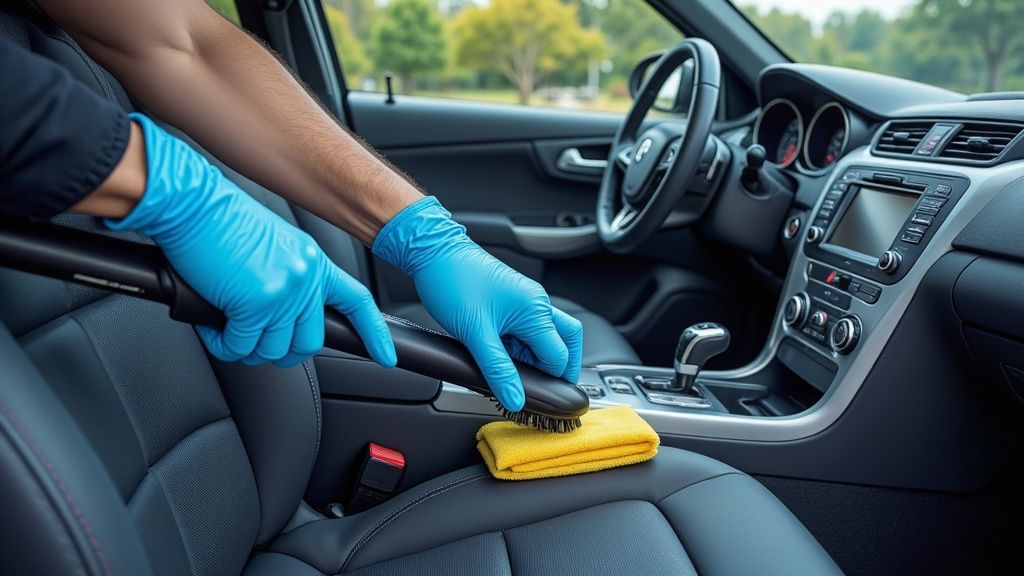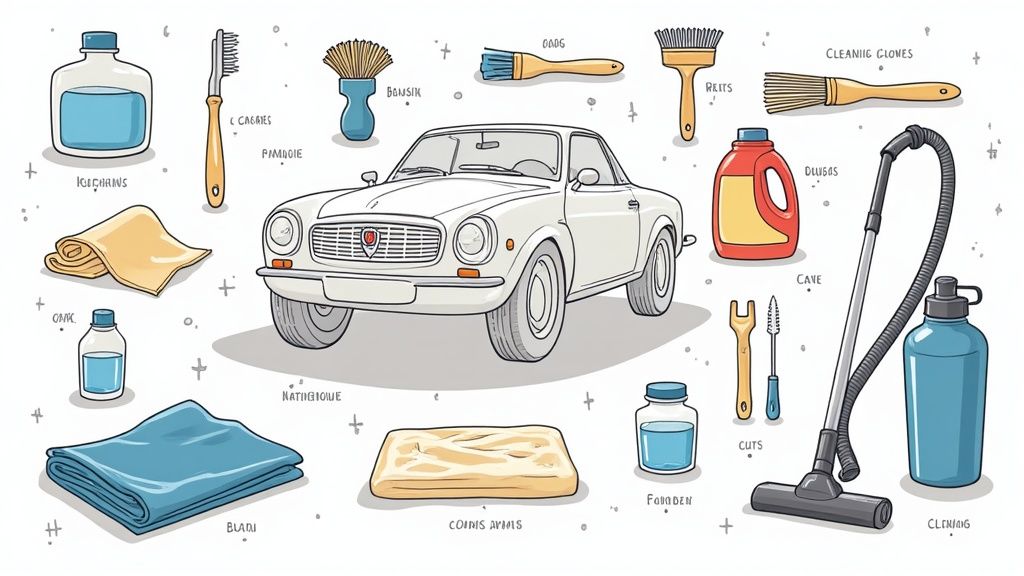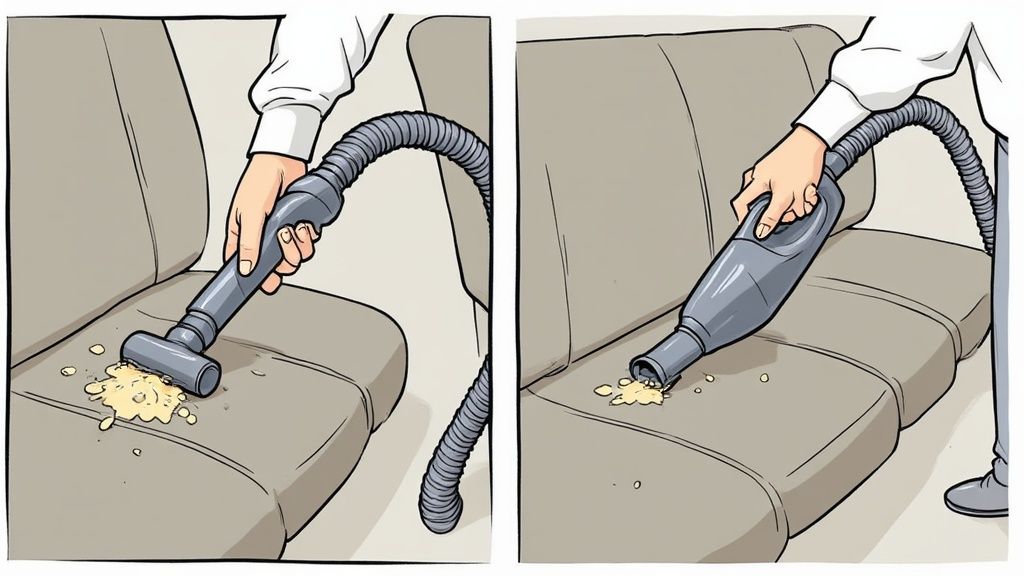
How to Detail Car Interior: A Step-by-Step Guide to Professional Results
Understanding the Art of Interior Detailing

Interior car detailing is much more than basic cleaning - it’s a careful process that makes driving more enjoyable. It requires knowing how different materials in your car react to sun exposure, temperature changes, and daily use. Good interior detailing protects these materials while keeping your car looking great. A well-detailed car holds its value better and creates a nicer environment for everyone.
Why Detailing Matters
Quality detailing focuses on both cleaning and protection. For example, using the right products on leather seats removes dirt while also protecting the material from cracking and fading. Taking care of stains quickly prevents permanent damage. This preventive approach keeps your car’s interior in top shape and helps avoid expensive repairs later.
The demand for professional interior detailing continues to grow as more people prioritize vehicle cleanliness and comfort. Research shows the interior detailing market is expected to grow at a CAGR of 6.7% from 2025 to 2030. This increase comes from people spending more time in their cars, especially in cities. Learn more in this car detailing market report.
Key Aspects of Interior Detailing
Professional detailing stands apart from basic cleaning in several important ways:
- Material Identification: Understanding what materials are in your car (leather, vinyl, plastic, fabric) is essential. This knowledge helps choose the right cleaning methods and products to avoid damage.
- Cleaning Techniques: Using proper tools like microfiber cloths prevents scratches on sensitive surfaces. Each area needs specific methods - from carpets to dashboard cleaning.
- Product Selection: Choosing appropriate cleaners for different materials is critical. Leather needs special cleaners and conditioners, while fabric requires different products entirely.
The Impact of Detailing
Learning proper interior detailing skills helps protect your car’s value over time. A clean, well-maintained interior can significantly increase resale value. Beyond financial benefits, a properly detailed car creates a more pleasant driving environment. This shows how professional detailing affects both practical and visual aspects of car ownership.
Building Your Professional Detailing Arsenal

To achieve professional-grade car interior detailing results, you need the right tools and products. A well-planned detailing kit helps create that showroom-quality finish that clients expect. Let’s explore the essential components that make the difference between basic cleaning and professional detailing.
Essential Tools for Detailing Success
These core tools form the foundation of professional detailing work:
- Microfiber Cloths: Multiple cloths in different colors for different areas (windows, dashboard, etc.) to prevent cross-contamination. The soft fibers clean effectively without scratching surfaces.
- Detailing Brushes: A range from stiff to soft bristles for cleaning various textures and reaching tight spaces effectively.
- Vacuum Cleaner with Attachments: High-powered vacuum with crevice tools, upholstery brushes, and extension wands to thoroughly remove dirt from every corner.
Adding a steam cleaner for deep cleaning fabric and carpets can significantly improve your results. These basic tools combined with proper technique create the foundation for quality work.
Choosing the Right Detailing Products
Quality products are just as important as proper tools:
- Interior Cleaners: While all-purpose cleaners work for basic jobs, specialized cleaners for leather and vinyl deliver better results
- Leather Conditioner: Essential for maintaining leather’s softness and preventing damage from wear and UV exposure
- Carpet and Upholstery Cleaner: Select cleaners matched to specific fabric types for best stain and odor removal
- Glass Cleaner: Use a quality streak-free formula for crystal clear windows
While premium products often perform better, many mid-range options provide excellent results. The global car detailing market reached USD 36.7 billion in 2024, with interior detailing showing the strongest growth potential through 2034. Learn more in this detailed market analysis.
Building Your Kit: A Balanced Approach
Start with essential tools and products, then expand your kit as your skills and client base grow. Focus on quality tools that last - they’re worth the investment. A complete professional kit enables you to handle everything from basic maintenance to full interior restorations. Build your arsenal gradually while maintaining high standards in your work.
Mastering the Interior Detailing Process

A clean car interior makes every drive more enjoyable. By following a systematic process and using the right tools, you can achieve professional-level results. Let’s break down the key steps to detail your car’s interior properly.
Initial Cleaning: Setting the Stage
Start with a thorough clean to prepare surfaces for detailed work. This foundation step is crucial for the best results.
- Remove Items: Take out all trash, personal belongings, and loose debris. This gives you a clear workspace and prevents damage to items during cleaning.
- Deep Vacuum: Use attachments to clean seats, carpets, mats, dashboard and crevices. Focus on spots where dirt collects, like under seats and between console gaps.
- Treat Stains: Apply stain remover to visible marks on fabrics and carpets. Let cleaners soak for the recommended time to work effectively.
A thorough initial clean makes the detailed work ahead much more effective.
Surface-Specific Detailing: A Targeted Approach
Different interior surfaces need specific cleaning methods and products. Using the right approach for each material prevents damage and ensures the best results.
- Dashboard and Console: Clean with a microfiber cloth and interior cleaner or mix distilled water, baby oil and white vinegar. Focus on removing fingerprints and marks.
- Leather Seats: Use leather cleaner and conditioner to clean and protect the material from cracking and fading.
- Fabric Seats: Apply upholstery cleaner with a brush to work it into fibers and lift dirt and stains.
- Glass: Clean windows and mirrors with streak-free glass cleaner and fresh microfiber cloth for perfect clarity.
The car detailing industry keeps growing, especially in Asia Pacific which held a USD 14.15 billion market share in 2022. See the full report at Fortune Business Insights.
Final Touches: Elevating the Detail
Complete the job with finishing touches that make the interior look truly professional.
- Door Areas: Clean and condition door panels and trim pieces. These often-missed spots affect the overall look.
- Floor Mats: Shampoo or wipe down mats thoroughly. Let them dry completely before putting back.
- Fresh Scent: Use an odor eliminator to remove any lingering smells and add a clean fragrance.
These final steps ensure your car’s interior looks and feels professionally detailed, creating an inviting space for every drive.
Professional Techniques for Superior Results

Taking car interior detailing to a professional level requires mastering specific techniques. Achieving excellent results means knowing how to properly restore leather, renew faded surfaces, and remove tough stains. Let’s explore these advanced methods that separate basic cleaning from professional detailing.
Reviving Leather and Restoring Trim
Quality leather care starts with proper cleaning using specialized leather products, followed by a high-grade conditioner to prevent cracking. For faded trim, specific restoration products can bring back the original color. After restoration, apply a UV protectant to prevent future damage and maintain the renewed appearance.
Eliminating Stubborn Bio-Contaminants
When regular cleaning methods fall short, addressing bio-contaminants needs a specialized approach. Using a steam cleaner helps eliminate mold, mildew and bacteria by reaching deep into fabric and carpet fibers. This method is especially important for creating a healthier environment for allergy-prone clients.
Utilizing Commercial-Grade Equipment
Quality results come from using the right tools. Professional extractors excel at deep-cleaning carpets and seats, removing dirt that normal vacuuming misses. Steam cleaners allow for effective sanitizing without damaging delicate materials when used correctly. Each surface needs the right cleaning method for optimal results.
Advanced Stain Removal Strategies
Difficult stains often require multiple steps to remove completely. Start with targeted stain removers, use appropriate brushes for agitation, then extract thoroughly. Quick action on fresh stains prevents them from becoming permanent fixtures in the upholstery.
Professional Approaches for Consistent Results
Top detailers follow a methodical process - carefully checking every area, understanding different material needs, and adjusting techniques based on the vehicle’s condition. Using Auto Service Logger helps track maintenance history and ensure consistent quality. This attention to detail sets professional work apart.
Professional-level detailing comes from combining the right techniques, tools and systematic approaches. Understanding proper cleaning methods and material care allows you to handle any detailing challenge effectively. This expertise leads to impressed clients and a strong reputation for quality work.
Creating a Maintenance Strategy That Works
Once you’ve detailed your car’s interior, you need a solid plan to keep it looking fresh. A practical maintenance approach helps preserve your hard work between major detailing sessions. Here are proven strategies for maintaining different interior materials and handling everyday situations.
Daily and Weekly Maintenance Routines
Quick daily cleaning prevents dirt from building up over time. Take 2-3 minutes each day to wipe down high-touch areas like the steering wheel, gear shift, and display screen. For daily cleaning, try this simple DIY spray: mix equal parts distilled water, baby oil, and white vinegar.
Make vacuuming carpets and seats a weekly habit to remove loose debris. Deal with spills and stains immediately - this prevents them from setting in and becoming permanent. These small daily and weekly habits save significant time and effort long-term.
Customized Maintenance Plans for Different Materials
Each interior material needs specific care methods. For leather, apply a quality cleaner and conditioner monthly to prevent cracking. Fabric seats benefit from regular vacuuming with an upholstery attachment to remove embedded dirt. When cleaning plastic and vinyl surfaces, use gentle, material-appropriate products - harsh chemicals can cause permanent damage.
Handling Spills and Stains Like a Pro
Keep emergency cleanup supplies in your car:
- Several microfiber cloths
- Small bottle of all-purpose cleaner
- Stain removal wipes
When spills happen, blot them immediately rather than rubbing, which can push stains deeper. For stubborn stains, use cleaners specifically made for your interior material type.
Empowering Clients Through Education
Professional detailers can add value by teaching clients proper maintenance techniques. Create personalized care plans based on each client’s vehicle and usage. Show them which products work best and demonstrate basic cleaning methods. Consider using Auto Service Logger to track maintenance history and provide detailed reports. This educational approach helps clients maintain their detailed interior while building long-term loyalty.
Overcoming Common Detailing Challenges
The art of detailing a car interior comes with its share of obstacles. From difficult stains to bad smells, knowing exactly how to handle these problems is essential for achieving great results. Here are proven solutions to help you tackle common detailing issues with confidence.
Tackling Stubborn Stains
Dealing with tough stains requires a systematic approach. First, identify both the stain type and surface material - this determines which cleaning method will work best. For fresh spills, gently blot with a clean microfiber cloth rather than rubbing, which can spread the stain further. Set-in stains need specialized cleaners designed for specific materials. Always do a small test patch first to check for any adverse reactions.
Eliminating Persistent Odors
Bad smells can ruin the driving experience. To effectively eliminate odors, you must find and treat the source - air fresheners only mask the problem temporarily. For organic-based smells, use enzyme cleaners that break down the cause. Steam cleaning carpets and upholstery helps remove odor-causing bacteria. While ozone generators can tackle smoke smells, they should only be used by professionals due to safety concerns.
Repairing Damaged Surfaces
Regular detailing often reveals minor damage like scratches and scuffs. Small scratches on plastic trim often improve with plastic restorers. While major tears in leather or vinyl need professional repair, minor damage has DIY solutions. Regular cleaning and conditioning can significantly improve worn surfaces and help maintain the car’s value.
Troubleshooting Specific Materials
Each interior material needs its own care approach. Leather requires regular conditioning to stay supple, while fabric needs special cleaning to prevent water spots. Plastic and vinyl surfaces need gentle cleaners to avoid damage. Using Auto Service Logger helps track which products work best on different materials, ensuring consistent results across multiple detailing sessions.
Ready to improve your auto detailing business? Auto Service Logger offers a complete system for managing vehicle maintenance records. Keep track of mileage, create detailed reports, and store service documents securely. Sign up for a lifetime membership to access personalized support and take your record-keeping to the next level.